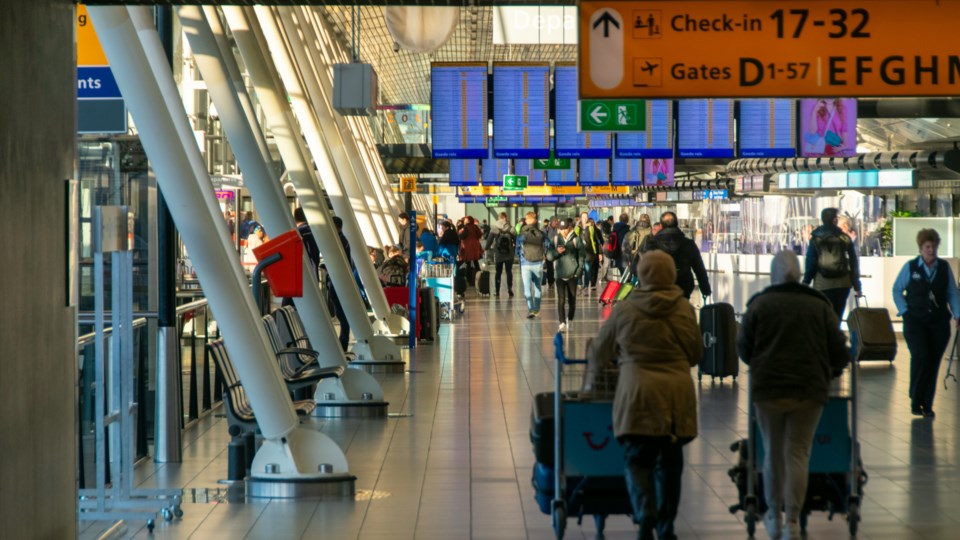People left behind 2 million items at airports in 2023, according to The Unclaimed Baggage Found Report. Just 10% of lost item requests are found.
Whether it's a beloved piece of jewelry or car keys, misplacing items is a stressful—and time-consuming—part of life. A 2023 Lostings survey found on average, a person spends 2.5 days a year looking for items they lost. But new tech innovations stand to decrease that statistic dramatically.
Tile, a Bluetooth tracker company, compiled travel industry data, news reports, and product information to illustrate how technology is reshaping the landscape of lost items.
When Andrew Jensen and Meredith VanAcker's vehicle was towed without notice to an unknown location, the couple spent a week cycling along their Brooklyn neighbourhood's streets, key fob in hand, trying to find the car. The couple joined the ranks of tech-savvy individuals pursuing an end to lost items: They outfitted their car with an e-tag to track its location in real time.
It's not just individuals: Hotels are also adopting digital lost-and-found technology. New apps can streamline the otherwise painstaking process of inventorying items left behind in rooms. Employees can photograph lost items using the app, which identifies the image with auto-tags that can even identify brand logos—and links the item to a GPS location stored in the app's database that other staff members can quickly access.
Next time you're on the go, consider the forthcoming hacks for leveraging tech to keep track of your most valued possessions.
Get some backup using Bluetooth trackers—but know the limits of their radius and battery life. Valerie Szybala's lost luggage fiasco went viral in late 2022 when the tracking device she installed on her suitcase showed her misplaced baggage taking a circuitous journey to reconnect with her—including stops at a McDonald's and at an apartment complex that was not Szybala's. A rep for the airline at the time claimed the luggage was in a secure location.
Tracking devices can locate items using Bluetooth technology. This technology sends an encrypted, anonymized SOS-like signal between mobile devices nearby to help pinpoint the location of whatever's tagged.
Different products are compatible with various smartphones, computers, and apps. Whatever product you use, check on the e-tag's battery life. Some products have a battery that lasts a year; others claim three years of use. Similarly, each product has a different range, with GPS trackers offering the furthest range of detectability without relying on a phone that must be reasonably close to maintain a Bluetooth connection.
Bluetooth technology can update users on the location of their items tagged with the product when they're within range. It works with Amazon's Alexa system, so you don't need to look at an app; instead, you can simply say, "Alexa, find my…"
When e-tags don't make sense, stick a Bluetooth or QR code label on them. You can outfit bike helmets, reusable water bottles, hard-shell luggage, and other small items with QR-coded stickers that, when scanned, reveal a custom message and contact information to facilitate the item's return. The stickers are less bulky and more affordable than e-tags.
According to the 2024 Uber Lost and Found Index, luggage, headphones, wallets, laptops, and tablets are among the top 10 most commonly forgotten items. All of these can be easily fitted with a QR sticker for simple returns.
Travel with an airline that uses RFID tag tracking. In 2016, Delta became the first major airline to utilize radio frequency identification tags. RFID tags are more efficient than barcode trackers but are only implemented in 27% of airports, according to the International Air Transport Association.
Air transport technology provider SITA reported the number of mishandled bags that were delayed, lost, stolen, damaged, or pilfered from 2021-2022 doubled across airlines and airports. The majority of mishandled luggage was attributed to staff shortages post-COVID.
Worldwide, 44% of airlines have adopted an international resolution to provide baggage tracking systems to follow luggage from check-in to arrival. By 2025, 67% of airlines plan to offer real-time information on travellers' luggage—up from 25% in 2023, according to SITA.
Keep it simple by leveraging your phone's settings. Instead of simply retracing your steps, many cell phones offer easy options to remember where an item was left. When you leave a designated location, you can use the reminder app to notify you of items you must not forget.
Google Maps and Apple Maps allow users to save their parking location within the app. But sometimes, just taking a picture of the street signs where you parked your car is enough to jog your memory—and save you a jog around the neighbourhood—to remember where it was.
Story editing by Nicole Caldwell. Copy editing by Kristen Wegrzyn.
This story originally appeared on Tile and was produced and distributed in partnership with Stacker Studio.




